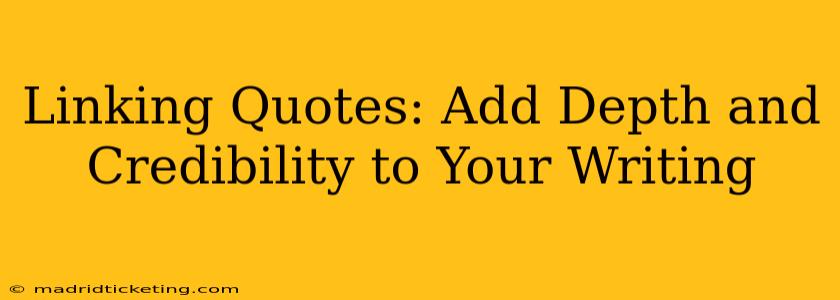In the realm of writing, whether it's crafting compelling blog posts, insightful articles, or persuasive essays, the effective use of quotes can significantly elevate your work. Quotes bring in expert opinions, add historical context, and lend weight to your arguments. However, simply dropping a quote into your text isn't enough. The real power lies in how you integrate those quotes, linking them seamlessly to your own narrative and providing sufficient context for the reader. This post will explore the art of linking quotes, transforming them from isolated snippets into powerful tools for enhancing credibility and depth in your writing.
Why Link Quotes?
Before delving into the techniques, let's understand the importance of linking quotes. Unlinked quotes appear jarring and disjointed, leaving the reader confused about their relevance to your overall point. Linking quotes serves several crucial purposes:
- Contextualization: A properly linked quote clarifies its source, the situation it pertains to, and its relevance to your argument.
- Attribution: Linking ensures you give proper credit to the original author, avoiding plagiarism and upholding academic honesty.
- Smooth Integration: Seamless integration makes the quote feel like a natural part of your writing, rather than a random insertion.
- Enhanced Credibility: Supporting your points with credible sources builds trust and authority with your audience.
- Strengthening Arguments: Well-placed quotes provide concrete evidence and bolster your claims, making your writing more persuasive.
Techniques for Linking Quotes Effectively
Here are some proven techniques to seamlessly integrate quotes into your writing:
1. Introducing the Quote with Context
Before presenting the quote, set the stage. Explain who said it, when, and under what circumstances. This provides the necessary background information for the reader to understand the quote's meaning and significance.
Example: During a 1963 speech in Washington D.C., Martin Luther King Jr. powerfully articulated his vision for racial equality, stating, "I have a dream that one day this nation will rise up and live out the true meaning of its creed: 'We hold these truths to be self-evident, that all men are created equal.'" This statement transcended its time and continues to inspire movements for social justice globally.
2. Using Signal Phrases
Signal phrases smoothly introduce quotes by using verbs that indicate the speaker's attitude or action. Examples include: stated, argued, claimed, suggested, explained, emphasized, asserted.
Example: According to renowned physicist Stephen Hawking, "The greatest enemy of knowledge is not ignorance, it is the illusion of knowledge."
3. Integrating Quotes Grammatically
Don't just drop a quote into your text. Instead, incorporate it grammatically into your sentence structure. You can use commas, colons, or semicolons to seamlessly blend the quote into your writing.
Example: The author eloquently captures the essence of solitude: "The silence was a heavy cloak, wrapping itself around me, muffling the world's clamor."
4. Analyzing and Interpreting the Quote
After presenting the quote, don't leave it hanging. Analyze its meaning, explain its significance in relation to your argument, and discuss its implications.
Example: Einstein's famous quote, "Imagination is more important than knowledge," challenges us to think beyond the confines of existing data. It suggests that creative thinking and the ability to envision possibilities are essential for progress and innovation.
Frequently Asked Questions (FAQs)
H2: How do I cite a quote properly to avoid plagiarism?
Proper citation depends on the style guide you're using (e.g., MLA, APA, Chicago). Generally, you need to include the author's name, the date of publication (if applicable), and the page number (for printed sources). Using a citation management tool can greatly assist with accurate and consistent citation.
H2: What if the quote is long? Should I use block quotes?
Yes, for quotes exceeding four lines, use a block quote. This involves indenting the quote and often using a smaller font size. Make sure to still properly introduce and cite the block quote.
H2: How can I shorten a long quote without changing its meaning?
You can use ellipses (...) to omit words or phrases from the middle of a quote. However, make sure the omission doesn't alter the original meaning. Always indicate omissions using ellipses.
H2: Can I paraphrase a quote instead of using it directly?
Yes, paraphrasing is a valuable alternative, especially when you want to convey the essence of a quote in your own words. However, you still need to properly cite the original source.
H2: What are some examples of different types of quotes I can use?
You can utilize various quotes such as direct quotes, indirect quotes (paraphrases), and partial quotes. The best type to use depends on your purpose and the context of your writing.
By mastering the art of linking quotes, you'll elevate your writing to new heights, making it more credible, persuasive, and engaging for your readers. Remember that the key is not just including quotes, but integrating them thoughtfully and effectively.

